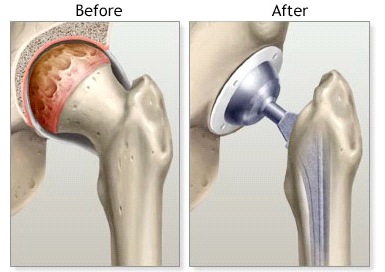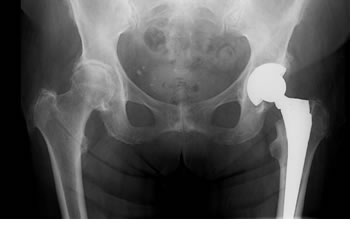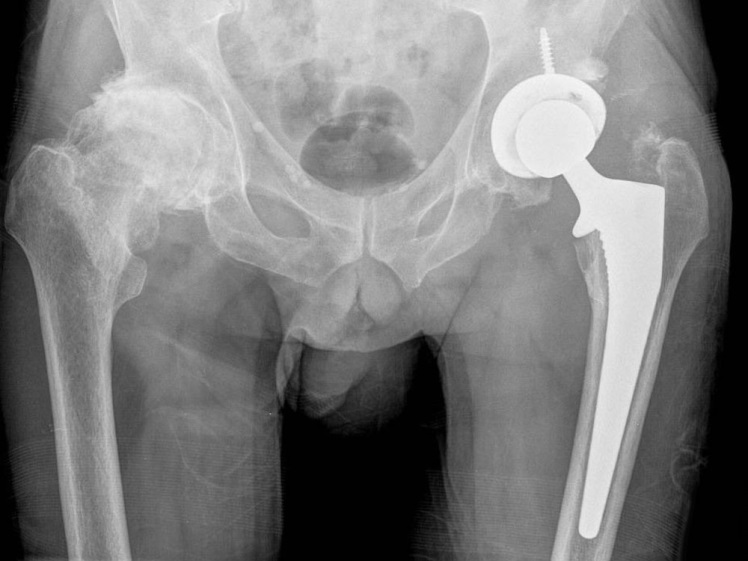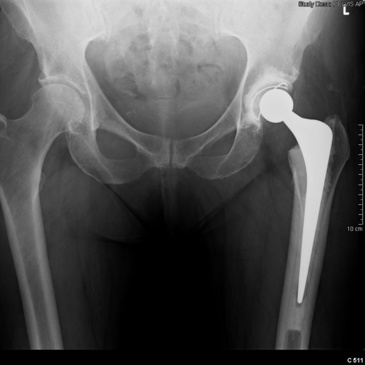- Home
- Dr Shailesh Keshav Mishra
- Arthroscopy
- Joint Replacement surgeries
- Arthritis care
- Type of Sports injuries
- Gallery
- Blogs
- Testimonials
- Contact Us
Hip replacement, or arthroplasty, is a surgical procedure in which the diseased parts of the hip joint are removed and replaced with new, artificial parts. These artificial parts are called the prosthesis. The goals of hip replacement surgery are to improve mobility by relieving pain and improve function of the hip joint. Surgeons remove both, ball (femoral head) and socket (acetabulum) and are replaced by prosthetic parts made of metal, ceramic and hard plastic (polyethelene).


The most common reason that people have hip replacement surgery is the wearing down of the hip joint that results from osteoarthritis. Other conditions, such as rheumatoid arthritis (a chronic inflammatory disease that causes joint pain, stiffness, and swelling), avascular necrosis (loss of bone caused by insufficient blood supply), injury, and bone tumors also may lead to breakdown of the hip joint and the need for hip replacement surgery.
Before considering a total hip replacement, the doctor may try other methods of treatment, such as an exercise program and medication. An exercise program can strengthen the muscles in the hip joint and sometimes improve positioning of the hip and relieve pain. The doctor also may treat inflammation in the hip with nonsteroidal anti-inflammatory drugs, or NSAIDs. In a small number of cases, the doctor may prescribe corticosteroids, such as prednisone or cortisone, if NSAIDs do not relieve pain. Corticosteroids reduce joint inflammation and are frequently used to treat rheumatic diseases such as rheumatoid arthritis. Sometimes Physical aid like cane or elbow crutch is advised to delay or avoid total hip replacement.
The hip joint is located where the upper end of the femur meets the acetabulum. The femur, or thigh bone, looks like a long stem with a ball on the end. The acetabulum is a socket or cup-like structure in the pelvis, or hip bone. This "ball and socket" arrangement allows a wide range of motion, including sitting, standing, walking, and other daily activities. During hip replacement, the surgeon removes the diseased bone tissue and cartilage from the hip joint. The healthy parts of the hip are left intact. Then the surgeon replaces the head of the femur (the ball) and the acetabulum (the socket) with new, artificial parts. The new hip is made of materials that allow a natural, gliding motion of the joint. Hip replacement surgery usually lasts 2 to 3 hours. Sometimes the surgeon will use a special glue, or cement, to bond the new parts of the hip joint to the existing, healthy bone. This is referred to as a "cemented" procedure. In an uncemented procedure, the artificial parts are made of porous material that allows the patient's own bone to grow into the pores and hold the new parts in place. Doctors sometimes use a "hybrid" replacement, which consists of a cemented femur part and an uncemented acetabular part.

Cemented Total Hip Replacement

Cementless Total Hip Replacement
After surgery, medical staff will monitor different health parameters like blood pressure, pulse, consciousness, pain or comfort level and need for medications.
Following measures will be taken to prevent the risk of blood clots in your legs:
Our clinic has some of the best doctors to perform the total him replacement surgery.
Some general rules for any activity you do are:
When you are getting dressed:
When you are sitting:
When you are bathing or showering:
When you are using stairs:
When you are lying in bed:
When you are getting into or riding in a car:
DO NOT drive until your health care provider says it is OK.
When you are walking:
The most common problem that may happen soon after hip replacement surgery is hip dislocation. Because the artificial ball and socket are smaller than the normal ones, the ball can become dislodged from the socket if the hip is placed in certain positions. The most dangerous position usually is pulling the knees up to the chest. Less common complications of hip replacement surgery include infection, blood clots, and heterotopic bone formation (bone growth beyond the normal edges of bone).